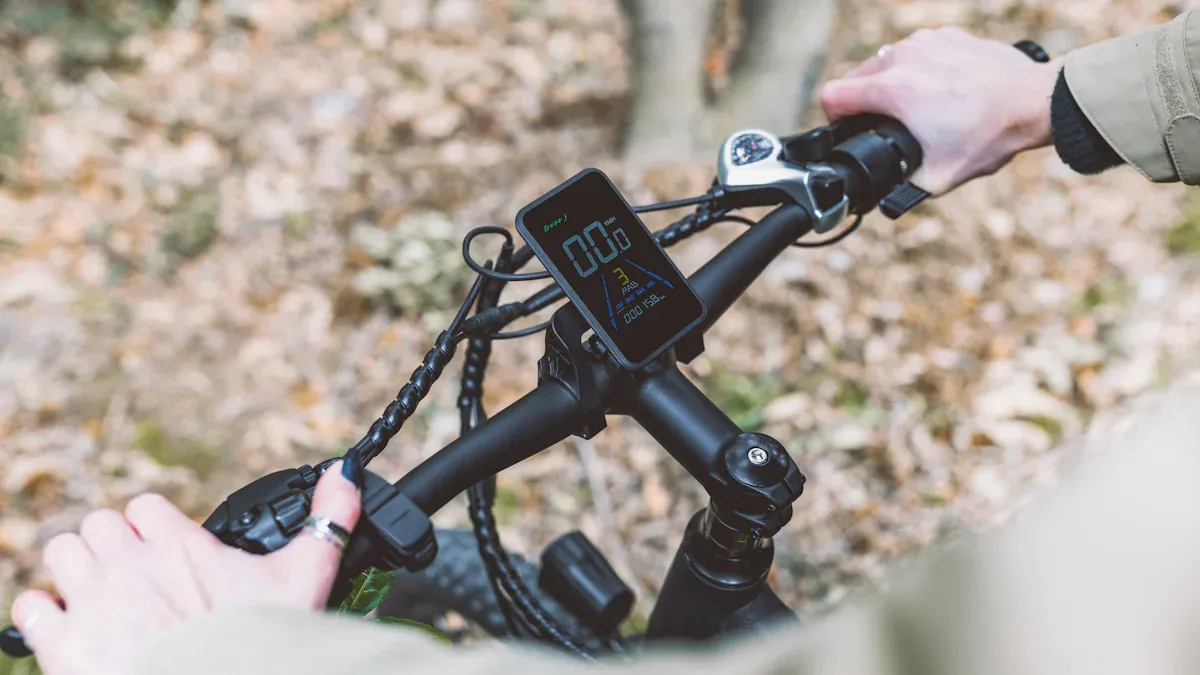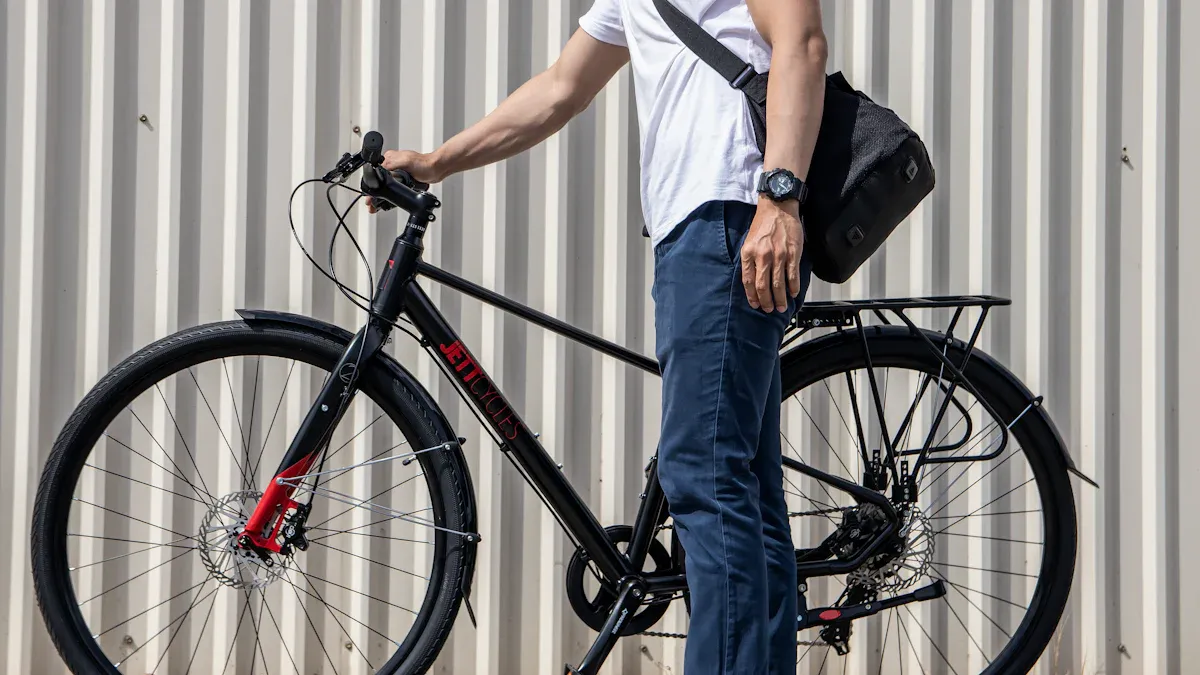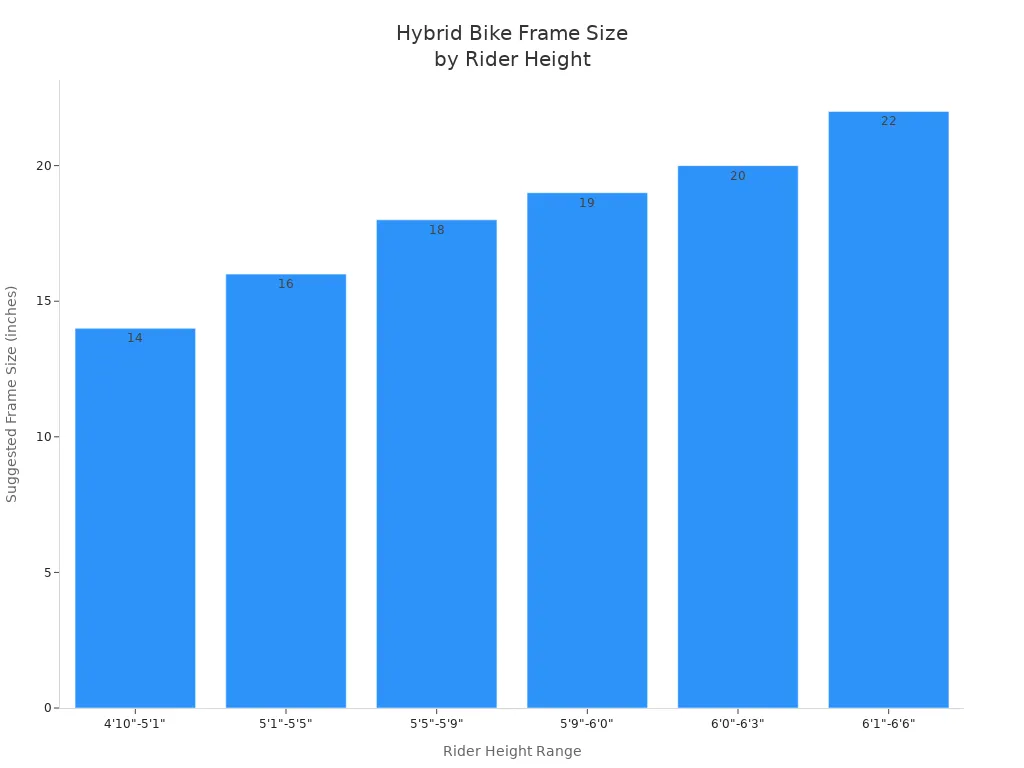
Choosing the right hybrid bike frame size is crucial for your comfort and performance on the road. A well-fitted bike can make your rides more enjoyable and help you avoid discomfort. You’ll want to pay attention to key measurements like your height, inseam, and reach. These factors play a significant role in ensuring that your hybrid bike feels just right as you pedal along.
Key Takeaways
Measure your height, inseam, and reach carefully. This helps you find a hybrid bike frame that fits well and feels good.
Use your height and inseam with sizing charts. This helps you choose the right bike size. You can pick larger or smaller sizes based on your body shape and likes.
Change your bike’s saddle height, handlebar position, and standover clearance. This makes riding more comfortable and helps avoid pain.
Keep in mind that bike sizes can be different by brand and model. Always check size charts and try bikes in person if you can.
Think about getting a professional bike fitting. This can help make your bike setup just for you, reduce discomfort, and improve your riding.
Key Measurements for Hybrid Bike Frame Size

When it comes to finding your ideal hybrid bike frame size, three key measurements play a crucial role: your height, inseam, and reach. Each of these measurements helps ensure that your bike fits you well, allowing for a comfortable and efficient ride. Let’s break down how to measure each one.
Measuring Your Height
To start, measuring your height accurately is essential. Here’s how you can do it:
Have someone mark the top of your head on the wall.
Measure from the floor to the mark.
This simple method gives you a good estimate of your overall size. You can then refer to sizing charts that correlate your height with recommended hybrid bike sizes. For example, if you’re between 160 cm and 170 cm tall, you might look for a frame size between 48 cm and 52 cm.
Measuring Your Inseam
Next, let’s talk about measuring your inseam. This measurement is vital for determining standover height and saddle height, which are crucial for comfort and control. Here’s how to measure your inseam:
Stand with your back against a wall and your feet shoulder-width apart.
Place a book between your legs, simulating a bike seat.
Measure from the top of the book to the floor.
This measurement helps you calculate your ideal hybrid bike size. A common formula is to multiply your inseam length in centimeters by 0.685 to find the recommended frame size in centimeters. For instance, if your inseam is 75 cm, your ideal hybrid bike frame size would be approximately 51.4 cm.
Measuring Your Reach
Finally, measuring your reach is essential for ensuring you have the right posture while riding. Reach affects how stretched out or upright you feel on the bike. Here’s how to measure it:
Sit on a bike with the saddle at the correct height.
Extend your arms forward to grasp the handlebars comfortably.
Measure the horizontal distance from the bottom bracket to the headset.
Adjustments to reach can be made through stem length, handlebar width, and saddle position. This ensures you maintain a natural riding position, reducing strain on your back and arms. Remember, comfort is key, especially on longer rides.
By taking the time to measure your height, inseam, and reach, you can confidently choose a hybrid bike frame size that suits you. These measurements not only help you find the right fit but also enhance your overall riding experience.
What Size Hybrid Bike Do I Need?
Choosing the right size for your hybrid bike can feel overwhelming, but it doesn’t have to be! By using your height and inseam measurements, you can find the perfect fit. Here’s a simple guide to help you determine what size hybrid bike you need.
Guidelines Based on Height and Inseam
Your height and inseam are the primary factors in selecting the correct frame size. Here’s a quick reference table to help you understand the recommended hybrid bike sizes based on these measurements:
Frame Size | Rider Height Range (cm/ft) | Inseam Range (cm/in) |
|---|---|---|
Small (S) | 72 – 78 cm (28.3″ – 30.7″) | |
Medium (M) | 165 – 175 cm (5’5″ – 5’8.9″) | 77 – 83 cm (30.3″ – 32.7″) |
Large (L) | 175 – 186 cm (5’8.9″ – 6’1.2″) | 82 – 88 cm (32.3″ – 34.6″) |
XL | 186 – 197 cm (6’1.2″ – 6’5.6″) | 87 – 93 cm (34.3″ – 36.6″) |
XXL | 197 – 203 cm (6’5.6″ – 6’7.9″) | 92 – 95 cm (36.2″ – 37.4″) |
This table reflects common recommendations from major hybrid bike manufacturers. It’s a great starting point for selecting your ideal hybrid bike size.
Additional Sizing Advice
If you find yourself between sizes, here are some tips to help you decide:
Choose the larger size if:
You have long arms or legs.
You prefer larger wheels, which the bigger size may offer.
Choose the smaller size if:
You have a longer torso but average or shorter limbs.
You experience mobility issues, like bad hips or back problems.
Remember, both men and women typically use the same sizing charts for hybrid bikes. However, youth bike sizing differs significantly, focusing more on wheel diameter than frame size. For example, younger riders often choose bikes based on wheel sizes that correspond to their age and height.
Using a bike size calculator can also help you find the correct frame size. By inputting your measurements, you can get a more tailored recommendation. Ultimately, knowing what size hybrid bike you need will enhance your riding experience and keep you comfortable on your journeys.
Properly Size and Fit a Bike

Getting your hybrid bike fit just right is essential for a comfortable ride. One of the first things to consider is the bike frame standover height. You want to maintain at least 1 to 2 inches of clearance between your inseam and the bike’s top tube. This space is crucial for comfort and safety. It allows you to mount and dismount easily while reducing the risk of injury. Remember, your inseam measurement is the key factor here, not just your overall height.
Next up is saddle height and position. Proper adjustments can significantly impact your riding efficiency and help prevent injuries. Here are some tips to ensure your saddle is set correctly:
Proper saddle height should be measured when your leg is fully extended at the bottom of the pedal stroke. This reduces strain on your knees and back.
A level saddle prevents excess pressure on your hands and lower back, enhancing comfort.
The fore-aft position of the saddle affects your weight distribution. If it’s too close to the handlebars, you might strain your mid-back. If it’s too far back, you could experience low back and neck pain.
To find the right saddle height, try the Heel Test:
Pedal with your heels on the pedals.
If your hips rock side to side, the saddle is too high.
If your leg doesn’t fully extend, the saddle is too low.
Adjust the height just below the point where your hips start to rock.
Now, let’s talk about handlebars. Adjusting them can make a world of difference in your bike fit. Here’s how to get it right:
Find a comfortable hand position where your shoulders are at about a 90-degree angle.
Adjust the stem height using spacers; comfort should guide your choice.
Test different stem lengths to find your ideal reach.
Rotate the handlebars for a neutral wrist position to reduce numbness.
Adjust brake levers to mimic your natural hand position for better control.
By taking the time to properly size and fit your bike, you’ll enjoy a more comfortable and efficient ride.
Understanding Manufacturer Differences in Bike Fit
When you’re shopping for a hybrid bike, you’ll notice that different brands have their own sizing systems. This can be confusing! Some brands use inches, while others prefer size categories like XS, S, M, L, and XL. The frame size usually refers to the distance from the center of the front chainring to the top of the seat tube. To find your perfect fit, you need to consider your height and inseam length.
Here’s a quick look at how sizing can vary among brands:
Sizing Systems: Some brands measure frame sizes in inches, while others use centimeters or alpha sizes. This inconsistency can lead to confusion.
Model Differences: Even within the same brand, different models may have varying sizing. For example, a medium in one model might fit differently than a medium in another.
Geometry Matters: Key measurements like stack and reach can help you compare fits more accurately. Stack measures the vertical height from the bottom bracket to the top of the head tube, while reach measures the horizontal length.
To help you visualize this, here’s a simple hybrid bike size chart that shows common frame sizes and their corresponding rider height and inseam ranges:
Size | Rider Height Range | Inseam Range |
|---|---|---|
S | Approximately 5’1″ to 5’5″ (155-165 cm) | 28.3″ to 30.7″ (72-78 cm) |
M | Approximately 5’5″ to 5’9″ (165-175 cm) | 30.3″ to 32.7″ (77-83 cm) |
L | Approximately 5’9″ to 6’1″ (175-186 cm) | 32.3″ to 34.6″ (82-88 cm) |
XL | Approximately 6’1″ to 6’5″ (186-197 cm) | 34.3″ to 36.6″ (87-93 cm) |
XXL | Approximately 6’5″ to 6’8″ (197-203 cm) | 36.2″ to 37.4″ (92-95 cm) |
Tip: Always check the specific size chart for the brand you’re considering. This will help you find the best fit for your body type.
Remember, sizing isn’t one-size-fits-all. Factors like your body proportions and riding style can affect how a bike fits you. If possible, try out different models in person. This way, you can ensure you’re getting the right fit for your needs.
Get the Right Bike Fit with Professional Help
When should you think about getting help from a professional bike fitter? Here are some important times to consider:
Buying a new hybrid bike: A professional fit helps you start with the right size and settings.
After you buy a bike: If you want to improve your comfort and performance, a fitting can help.
For older bikes: If you have been riding for a long time, your body might change. A fitting can help adjust for those changes.
Feeling discomfort: If you have pain, numbness, or tiredness while riding, it’s time to get help. These signs often mean your bike fit needs changes.
Professional bike fitting looks at your unique body and riding goals. It can help you feel more comfortable and perform better.
Now, let’s look at the benefits of talking to a bike fitting expert. Here’s what you can expect:
Personalized assessment: A fitting includes checking your health history, how you move, and how you sit on the bike.
Pain relief: Many riders feel discomfort in their neck, knees, back, or wrists. A fitting can help reduce these problems.
Better comfort: You’ll have a more enjoyable ride, which can lead to longer and more fun cycling times.
Improved performance: Studies show that a good bike fit can help you ride better and longer. For example, research shows that the right saddle can reduce numbness and help blood flow.
Here’s a quick look at the usual costs for professional bike fitting services:
Service Type | Description | Typical Cost (USD) |
|---|---|---|
Basic Existing Bike Fit | Rider interview, physical check, position adjustment on current bike | $100 |
Size Cycle Fit (Existing Bike) | Performance and comfort goals addressed using Serotta Size Cycle, coordinate documentation | $200+ |
Size Cycle & Computrainer Performance Fit (New/Custom Bike) | Full biomechanical positioning for custom bike design | $250 |
Power Up/Retul Pro Bike Fit | Advanced motion capture and biomechanical analysis, 2-3 hours session | $300 |
Spending money on a professional bike fit can greatly improve your cycling experience. You’ll not only get the right bike fit but also enjoy a more comfortable and efficient ride.
Picking the right hybrid bike frame size is very important for your comfort and how well you ride. Getting the right measurements—like your height, inseam, and reach—helps you find the best fit. Remember, riding a bike that is too big or too small can cause discomfort and even long-term problems like back pain or wrist strain.
Tip: If you are not sure about your fit, think about getting help from a professional. They can help you find the right size and make changes for a better ride.
By measuring correctly and maybe asking an expert, you will improve your cycling experience and enjoy every ride more!

FAQ
What if I’m between two bike sizes?
If you find yourself between sizes, choose the larger size for more comfort and stability. Opt for the smaller size if you prefer a more agile ride or have shorter limbs.
How do I know if my bike is too big or too small?
You can tell if your bike is too big if you struggle to reach the handlebars or feel unstable. If it’s too small, you may feel cramped and uncomfortable during rides.
Can I adjust my bike after purchasing it?
Absolutely! You can adjust the saddle height, handlebar position, and even the stem length. These tweaks can significantly improve your comfort and riding experience.
How often should I get my bike fitted?
Consider getting a bike fitting whenever you buy a new bike, experience discomfort, or change your riding style. Regular adjustments can enhance your comfort and performance.
What should I wear for a bike fitting?
Wear comfortable clothing and your usual cycling shoes. This helps the fitter assess your natural riding position and make accurate adjustments.
See Also
Discover The Perfect Bike Fit Using Frame Size Tools
Easily Determine The Best Downhill Bike Frame Size
Guide To Accurate Bike Sizing With Frame Size Charts
Understanding Mountain Bike Geometry To Choose The Right Size
